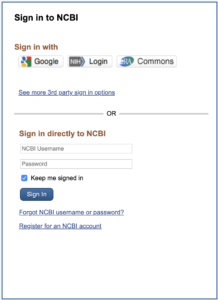Source:
NIH Public Access Policy (2024)
NIH Public Access Policy (2008)
Impacts: Peer-reviewed author accepted manuscripts that are the result of any level of NIH funding and accepted for publication in journals. Manuscripts accepted for publication on or after July 1, 2025, will utilize the 2024 policy. Scholarly manuscripts accepted for publication between April 7, 2008, and June 30, 2025, should follow the 2008 policy.
Timeline (2024):
- An author accepted manuscript should be submitted to PubMed Central on acceptance and before its official publication date, which is the date the final, edited work is first made available in a print or electronic format.
- The full text of the manuscript will be made publicly available without embargo on its official date of publication.
Timeline (20008):
- Manuscripts submitted within 3-months of the official journal publication date, or submitted directly to PubMed Central by the journal or publisher, are considered compliant.
- Manuscripts with or without an NIHMS identification number that are 3-months past the official publication date are non-compliant until they receive a PMCID.
- Journals or publishers may require a 0-to-12-month embargo of the manuscript’s full text in PubMed Central.
See Submitting a Manuscript (below) for information on the different submission methods.
Who Submits: Authors, associated PI’s or 3rd parties (grant managers, delegates, etc.)
What to Submit: Peer-reviewed author accepted manuscripts that are the result of any level of NIH funding and accepted for publication in journals. Versions of record may be submitted if author holds copyright (e.g., open access) or has permission.
Format: Wide range of formats acceptable
Where to Submit: NIH Manuscript Submission System (NIHMS)
Public Access Repository: PubMed Central (PMC)
Submission Notes
This is an accordion element with a series of buttons that open and close related content panels.
Submitting a Manuscript
Peer-reviewed manuscipts derived from research funded by NIH awards and accepted for publication must be submitted to PubMed Central (PMC) via the NIH Manuscript Submission System (NIHMS).
According to the 2008 policy, manuscipts submitted within three months of publication will receive an in-progress and compliant status in eRA Commons progress reports. This status will become non-compliant at the end of the 3-month period until a PMCID is issued.
Manuscripts may be submitted through four submission methods (A,B,C,D). The method used to submit a paper to the NIHMS depends on the journal or publisher’s submission policy. Principal investigators and authors are encouraged to check their journal’s author information page for guidance on which method will be used.
Method A
If the article is published in a journal that submits all NIH-funded final published articles to PMC no additional action or effort is required. Check this list of Method A journals to see if your journal is listed.
Method B
Arrangements can be made with a publisher, usually for a fee, to submit the final journal article directly to PMC. In some cases, the journal will do so if an NIH award number is acknowledged in the manuscript. Not all publishers offer this service. Check this list of Method B Publishers if you are interested in using this service.
Method C
An author, PI associated with a paper, or third-party may deposit a copy of the final peer-reviewed manuscript in PMC via the NIH Manuscript Submission (NIHMS) system.
Method C Best Practices
Method C: Instructions for authors and PIs submitting a manuscript
Method C: Instructions for submitting a manuscript on behalf of an author or PI
Method D
A publisher will automatically submit accepted papers to the NIHMS, though their timeline for doing so may cause the paper to surpass the 3-months-from-publication window the NIH encourages. Check this list of Method D publishers to determine if your publisher is a Method D publisher.
NIH Manuscript Submission System (NIHMS)
Authors, PI’s and third-parties may submit manuscripts for themselves or others. However, before any paper submitted through Methods C or D will be uploaded into PubMed Central (PMC), an author or PI associated with the paper must approve the initial submission and the reformatted end-product.
The NIHMS submission process typically takes 2-3 weeks.
The basic NIHMS submission steps include:
| Step | Description |
 |
Step 1: Deposit Files
A manuscript may be submitted by the author, the PI, the publisher, or another third party. Third-party submitters must designate an author or PI to serve as the Reviewer for an NIHMS submission. The Reviewer will receive notification of the deposit via e-mail. |
 |
Step 2: Initial Approval
The Reviewer reviews the submission, confirms or adds associated funding, and either rejects or approves the material for processing in NIHMS. |
 |
Step 3: NIHMS Conversion
NIHMS staff reviews the approved files for completeness, and complete submissions are converted to archival XML. The PMC-ready documents (Web and PDF versions) are checked to ensure they accurately reflect the submitted files. An e-mail notification is sent to the Reviewer when the record is available for final review. |
 |
Step 4: Final Approval
The Reviewer reviews the PMC-ready documents (Web and PDF versions) and either requests corrections or approves them for inclusion in PMC. Final Approval is required to complete manuscript processing in NIHMS. |
 |
Step 5: PMCID Assigned
A PMCID is assigned when Final Approval is complete and the manuscript is matched to a PubMed record with complete citation information. For details, see When will a PMCID be assigned to my manuscript? in the NIHMS FAQ. |
 |
Step 6: Publicly Accessible
Manuscript is made available in PMC following the publisher-required embargo period (if applicable). |
Source: NCBI (www.ncbi.nlm.nih.gov/books/NBK3846)
Successful NIHMS submissions include:
- NIH funding associated with the paper
- A digital copy of the author accepted manuscript (version of record with publisher or journals permission), images, and supplementary information
- The paper’s citation information
- A designated reviewer associated with the paper
The NIHMS will email the designated reviewer requests for approval. Reviewers may also check their NIHMS accounts for approval requests.
Only papers that receive both approvals will be uploaded into PMC and receive their PubMed Central Identification Number (PMCID), indicating public access compliance.
NIHMS Submission Status Guide
An NIHMS submission goes through various internal stages of processing. The status of a submission serves to indicate what action(s) are being taken or are needed by the submitter or the designated reviewer.
| Status | What it means |
| Submitter’s Action Required Prior to File Upload | The Submitter has initiated a submission but has not yet input title information. |
| Submitter’s File(s) Required | The Submitter has not yet completed the initial file upload or has received a request for missing or higher quality files following completion of the Initial Approval step. |
| Submitter’s Initial Approval or Designation of Reviewer Required | The Submitter has provided files but has neither approved the submission for processing nor assigned a Reviewer to approve the submission. |
| Reviewer’s Initial Approval Required | A notification that the manuscript is available for review has been sent to the Reviewer. He or she should log in, review the deposit, and sign off on the Submission Statement. |
| Reviewer’s Approval of the Submission Statement Required | The Reviewer has not yet agreed to the Submission Statement and needs to log in to review and sign off on it to move the submission forward. |
| Submitter’s Action Required Following Reviewer’s Rejection of Initial Submission | The Reviewer has rejected the submission. The Submitter should log in to the system to make any necessary adjustments to the submission before sending it back to the Reviewer. |
| NIHMS Evaluation of Reviewer’s Rejection of Initial Submission | The Reviewer has rejected the submission. NIHMS staff is reviewing the reason for rejection and will act accordingly, either by removing the submission or contacting the Reviewer. |
| NIHMS Submission Review and File Preparation | NIHMS staff is reviewing the deposit to ensure it meets submission requirements before continuing with conversion to archival XML format. |
| NLM Verification of Journal Information | NIHMS staff is reviewing the associated journal’s status in the NLM Catalog. NLM’s catalogers may need to create a new record for the journal before processing can continue. |
| NIHMS Conversion to PMC-Ready Documents | PMC-ready documents (Web and PDF) are being created from the deposited files, or updated, in archival XML format. |
| NIHMS Review of PMC-Ready Documents | NIHMS staff compares the PMC-ready documents against the original submission to ensure no errors were introduced (see NIHMS Conversion) and that any requested corrections have been made.
|
| Reviewer’s File(s) Required | A request for missing or higher quality files not caught during initial review or a request for files required to make a Reviewer-requested change to the PMC-ready documents has been sent to the Reviewer. He or she should log in and supply the files required to update the material. |
| Reviewer’s Final Approval Required | A notification that the PMC-ready documents are available has been sent to the Reviewer. He or she should log in, review the PMC-formatted Web and PDF versions, and either approve them or request corrections. |
| NIHMS Revision of PMC-Ready Documents Following Reviewer’s Rejection | The Reviewer has requested corrections to the PMC-ready documents. NIHMS staff is addressing the correction request. |
| Pending Final Citation Data | This status applies only to records that do not have final citation information following the Reviewer’s approval of the PMC-ready documents. Final citation information is required to determine the PMC release date. If the manuscript was published in a non-MEDLINE-indexed journal, it will be listed in the Awaiting Citation Data filter of an associated person’s manuscript list. He or she may provide citation information by clicking on the Provide Citation button in the manuscript record. |
| Sent to PMC | When a submission is queued to go into PMC, it is referred to as being “sent to PMC.” This involves sending the PMC-ready documents to the database and any citation or embargo information to PubMed. The PMCID has not yet been assigned. |
| Under embargo in PMC (PMCID Assigned) | PMC has received the manuscript and a PMCID has been assigned; however, the manuscript is not yet publicly available because it is under embargo. |
| Available in PMC | PMC has received the manuscript, a PMCID has been assigned, and PMC users can now access the full manuscript text. |
| Withdrawn from PMC | The manuscript has been removed from PMC. This is rare and usually occurs because it has been determined that the manuscript does not fall within the scope of the NIH or participating funder’s public access policy and should therefore not have been submitted. The PMCID is no longer valid for compliance purposes. |
Source: NIHMS (https://www.nihms.nih.gov/about/overview)
My NCBI and My Bibliography
My NCBI is a tool that allows researchers to save searches and results from multiple NCBI databases. Additionally, it’s My Bibliography function allows authors to record and manage their citations, including checking their citations’ public access compliance status.
Researchers or support staff may create or sign-in to My NCBI accounts using their eRA Commons, NIH, Google or university credentials. Users without credentials may register for a free NCBI account.

My Bibliography
One of the most useful functions of a My Bibliography list is that as long as a citation is associated with a funding award and the My NCBI account is linked with a PI’s eRA Commons account, it is possible to see the public access compliance status of the citation.
How to Link eRA Commons and NCBI accounts
Citations associated with a PI’s awards in a My Bibliography list will also automatically appear in those awards’ progress reports (RPPR’s).
For more information on My Bibliography functions:

